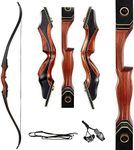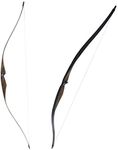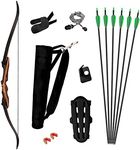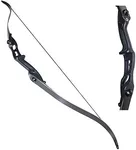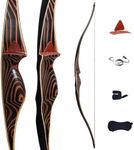Buying Guide for the Best Recurve Bows
Choosing the right recurve bow is all about matching the bow to your body, skill level, and intended use. Whether you’re interested in target archery, hunting, or just recreational shooting, understanding the key features of a recurve bow will help you make a confident decision. Focus on how the bow feels in your hands, how easy it is to draw, and whether it suits your shooting style. Always consider your own strength, experience, and what you want to achieve with your bow.Draw WeightDraw weight is the amount of force required to pull the bowstring back to a full draw. This is important because it affects how much power your shot will have and how comfortable the bow is to use. Lower draw weights (15-25 lbs) are easier to pull and are best for beginners, youth, or those interested in target practice. Medium draw weights (25-40 lbs) are suitable for more experienced archers or those looking to hunt small game. Higher draw weights (40 lbs and above) are typically used for hunting larger game and require more strength and experience. To pick the right draw weight, consider your physical strength and what you plan to use the bow for—start lower if you’re new, and increase as you build strength and skill.
Bow LengthBow length refers to the total length of the bow from tip to tip. This matters because it affects the bow’s stability and how smooth it feels when shooting. Shorter bows (48-62 inches) are more maneuverable and better for smaller archers or those shooting in tight spaces, but they can be less forgiving for beginners. Longer bows (62-70 inches) offer more stability and are easier to shoot accurately, making them a good choice for target archery and beginners. Choose a bow length that matches your draw length and shooting environment—longer for accuracy and comfort, shorter for portability and tight spaces.
Riser MaterialThe riser is the central part of the bow that you hold, and it can be made from wood, metal, or composite materials. The material affects the bow’s weight, balance, and feel. Wooden risers are traditional, often lighter, and have a classic look, making them great for beginners and those who appreciate aesthetics. Metal or composite risers are more durable, often heavier, and provide better stability, which can help with accuracy. Pick a riser material that feels comfortable in your hand and matches your preference for tradition or modern performance.
Limb MaterialThe limbs are the flexible parts of the bow that store energy when you draw the string. They can be made from wood, fiberglass, carbon, or a combination. Wooden limbs are traditional and offer a smooth draw, while fiberglass and carbon limbs are more durable and can provide more power and speed. If you’re just starting, wooden or fiberglass limbs are usually sufficient. As you gain experience, you might prefer carbon limbs for their performance and longevity. Choose limb material based on your experience level and how much performance you want from your bow.
Takedown vs. One-PieceRecurve bows come in takedown or one-piece designs. Takedown bows can be disassembled into three parts (riser and two limbs), making them easier to transport and allowing you to upgrade limbs as you progress. One-piece bows are a single, solid unit, offering a traditional feel and often a quieter shot. If you value portability and the option to upgrade, a takedown bow is a good choice. If you prefer simplicity and tradition, a one-piece bow might suit you better.
Grip Shape and SizeThe grip is where your hand holds the bow, and its shape and size can affect comfort and accuracy. Some grips are slim and rounded, while others are larger and more contoured. A comfortable grip helps you shoot consistently and reduces fatigue. Try different grip shapes to see what feels natural in your hand, especially if you plan to shoot for extended periods.
Brace HeightBrace height is the distance between the bowstring and the deepest part of the grip. This affects how forgiving the bow is to shoot and how much noise or vibration you feel. A higher brace height (7-9 inches) is more forgiving and better for beginners, while a lower brace height (6-7 inches) can offer more speed but requires better technique. Choose a brace height that matches your skill level—higher for ease and comfort, lower for performance as you gain experience.

